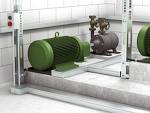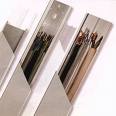Rules for joint laying of wires and cables for various purposes
The level of electrical noise in measuring devices (measurement accuracy), and sometimes the operability of automation systems as a whole, depends on the conditions for laying the measuring circuits of different devices with each other, as well as on the measuring circuits with other circuits of automation systems and power supply of an automated object.
Impact of interference when laying different destination wires and cables together
Interference in the measuring lines of devices can occur, for example, under the influence of external electromagnetic fields caused by the operation of industrial electrical installations (induction furnaces, current wires, etc.), as well as due to the presence of capacitive connections between different circuits located in one cable, protective tube or bundle of wire.
Note that interference caused by inductive connections between measurement circuits placed in the same cable does not significantly affect the performance of the devices.However, their influence becomes predominant when taking into account interference from power cables or other current conductors to cables with measuring circuits of devices laid along the same route. Disturbances caused by conducting the insulation of wires and cables at the nominal level of insulation are practically small.
 Not only the measurement circuits of the devices are affected by interference. Due to capacitive couplings, control circuits, alarms, etc. They also influence each other. For example, in AC control circuits where there are long cable runs containing circuits with a common return wire, false circuits can form and false alarms can occur in other devices. Therefore, when designing and installing electrical wiring for automation systems, it is very important to correctly solve the issue of joint laying of circuits for different purposes. On the one hand, the normal operation of automation systems depends on it, and on the other hand, the capital costs associated with the implementation of electrical wiring.
Not only the measurement circuits of the devices are affected by interference. Due to capacitive couplings, control circuits, alarms, etc. They also influence each other. For example, in AC control circuits where there are long cable runs containing circuits with a common return wire, false circuits can form and false alarms can occur in other devices. Therefore, when designing and installing electrical wiring for automation systems, it is very important to correctly solve the issue of joint laying of circuits for different purposes. On the one hand, the normal operation of automation systems depends on it, and on the other hand, the capital costs associated with the implementation of electrical wiring.
Requirements for laying wires and cables for various purposes
 Currently, there are practically no regulatory documents for laying electrical circuits that take into account the influence of electrical disturbances on the operation of various devices of technological process automation systems. Long-term operation one or another technological unit allows you to draw conclusions about the requirements for the implementation of electrical wiring of automation systems in order to take them into account when developing automation devices for similar technological processes.
Currently, there are practically no regulatory documents for laying electrical circuits that take into account the influence of electrical disturbances on the operation of various devices of technological process automation systems. Long-term operation one or another technological unit allows you to draw conclusions about the requirements for the implementation of electrical wiring of automation systems in order to take them into account when developing automation devices for similar technological processes.
In the absence of the specified regulatory materials or operating data, the recommendations of the device manufacturers should be followed, although these are most often prepared based on the conditions of laying the circuits of a device.
This article contains a number of requirements regulating the joint laying of electrical wires for various purposes, which must be taken into account when designing and installing automation systems.
It is allowed to combine measuring, control, signal, power, etc. circuits in one cable, protective tube, wire, etc., including supply and control circuits of electric motors of actuators and electric valve actuators, voltage up to 440 V AC and DC, except:
a) measuring circuits of instruments and automation equipment, in which there are disturbances resulting from the influence of the circuits of another destination exceeding the permissible values. In all cases where it is not possible to assess the indicated impact, it is possible to lay the measuring circuits of the devices in separate cables or protective pipes;
b) mutually redundant power circuits, control. In multi-channel channels, circuits of different purposes and voltages can be located in different channels;
c) permanently laid circuits supply voltage up to 42 V for electrified instruments and lighting on board according to safety rules;
d) circuits of fire alarm systems and fire automation.If there are instructions from instrument manufacturers regarding the need to lay measuring circuits with special wires (shielded, coaxial, etc.), then these requirements must be met; otherwise, the normal operation of the devices is not guaranteed.
When laying cables for electrical wiring of automation systems with power cables of power installations and power electrical equipment in ducts, tunnels and outdoors on cable structures in industrial premises and outdoor installations, the following requirements must be observed:
a) with two-sided arrangement of cable structures (racks) cables if possible, the electrical wiring of the automation systems should be included on the opposite side of the power cables;
b) in the case of one-sided arrangement of cable structures, the cables of the automation systems must be placed under power cables, while they are horizontal separating asbestos-cement partitions with a fire resistance limit of at least 0.25 h;
c) cables of electrical wiring of automation systems can be laid next to each other (on the same shelves) with power cables up to 1000 V, if applicable under the conditions of joint laying;
d) cables of automation electrical wiring systems with mutually redundant circuits are recommended for power supply, control, etc. lie on different shelves, separated by asbestos-cement partitions with a fire resistance limit of at least 0.25 hours;
e) the vertical clear distance between the horizontal structures from which the cables of the automation systems are laid must be at least 100 mm; distance between placed cables one shelf, not standardized.
Taking into account the possibility of joint laying of circuits for different purposes, very important for a wide range of introduction of modern installation methods, the issue of the use of electrical cables with a large number of cores in electrical systems.
Methods of implementing joint wiring of automation systems
 In the design of electrical wiring using multi-core cables, the circuits of sensors, primary measuring transducers, actuators, etc., scattered in the automated facility, are combined in distribution boxes and a cable (or cables) with a large number of cores.
In the design of electrical wiring using multi-core cables, the circuits of sensors, primary measuring transducers, actuators, etc., scattered in the automated facility, are combined in distribution boxes and a cable (or cables) with a large number of cores.
If local shields are also provided in the production facilities, then the association sensor circuits, primary measuring transducers, executive mechanisms are produced on these boards, etc. At the point of entry of trunk cables into the panel room, terminal mounting cabinets are installed, on which all the necessary connections (jumpers) are made. If there are several cabinets for mounting clamps, then the clamps can be installed in separate rooms adjacent to the switchboard room.
Electrical wiring from the terminal assembly cabinets to the corresponding panels of the control panel is carried out with wires in boxes or on trays or cables on cable structures, in boxes, on trays, in cable channels, double floors.
The use of multi-core trunk cables allows to reduce the consumption of cable products; to reduce the installation time due to the possibility of laying trunk cables, regardless of the completion of the installation of technological equipment and the readiness of the control room: to improve the technology for carrying out installation cable works; reducing the time required for installation work in the operator (control rooms), significantly reducing the number of jumpers between panels by making the necessary connections in the cabinets for mounting brackets, etc.
